United States News
See other United States News Articles
Title: Forensic acoustic proof of SECOND shooter in the Las Vegas massacre
Source:
[None]
URL Source: https://www.youtube.com/watch?v=JxmEFeKy8aI
Published: Oct 11, 2017
Author: Mike Adams TheHealthRanger
Post Date: 2017-10-11 00:40:47 by A K A Stone
Keywords: None
Views: 56566
Comments: 148
Post Comment Private Reply Ignore Thread
Top • Page Up • Full Thread • Page Down • Bottom/Latest
Comments (1-62) not displayed.
.
.
.
#63. To: nolu chan (#62)
You obviously don't understand what delisting is.
[ posted to wrong thread ]
It means it won't show up in a google search. It is removed from the index. If it is not in the index, it cannot be found in the index. If it is still there, it is not delisted.
If KlingonBurger.com got delisted then they wouldn't show up in a search for "healthy burgers in gamma quadrant 4" That kinda how it works?
You still pushing the teleportion echo theory I see. Paddock teleporting around shooting and your Klingon pic there to teleport him back and forth as he pleases.
Paddock teleporting around shooting and your Klingon pic there to teleport him back and forth as he pleases. There's as much evidence for that as there is "PROOF!" that Paddock wasn't the only murderer.
Agreed I'm the infidel... Allah warned you about. كافر المسلح
Supposedly, they will produce an official timeline and more complete official reporting sometime tomorrow. Should be interesting. The rest of this amateur hour sleuthing via YouBoob videos is just a distraction.
If I didn't help process the scene or at least respond to the incident, I'd never spend a single minute trying to GUESS what actually happened. Some people get a chubby out of that shit. I've responded and or handled many high profile crime scenes... and over the following weeks until the full incident is reported by LE, I've heard the most retarded conspiracy theories... when I know what actually happened. It's not even laughable. I'm the infidel... Allah warned you about. كافر المسلح
A lot of the CT peddlers know full well they're hawking complete BS. But their objective is monetizing videos on YouBoob and driving clicks to their clickbaity websites. We're seeing a steady stream of these frauds and their fanbois here at LF, from the Niburu/Planet X people to that Health Ranger idiot. So of course only idiocy can result from discussing any of it. There are a lot of unanswered questions about Vegas. Hopefully, some of that will be cleared up tomorrow if they produce their big timeline and evidence dump as promised.
Adams assumes a shooter using an AR-15 with .223 Remington 55 grain ammo. He states 20% humidity. He states a 925 m/s bullet velocity which is ~3034.8 fps. He specifies a 16.5" barrel, but a 3034.8 fps initial velocity would seem to indicate a 20" barrel or different ammo. I believe the white board has an error. The flight time should be 0.532s, not 0.528s. It lists both the 400 yard flight time and the lag time as 0.528s. This would mean the bullet velocity was precisely double the speed of sound, and that double 0.528s, or 1.056s would be the 400 yard travel time for the speed of sound. The time of sound travel for 400 yards at 1130 fps is 1.062. http://gundata.org/blog/post/223-ballistics-chart/ He cites his use of a gundata ballistics chart for travel time. gundata indicates for 400 yards, the time of travel is 5.32s, specifying a standard 55gr Remington .223 bullet leaving the barrel at 3,215fps. Adams also specified a 16.5 inch barrel, but it seems an AR-15 with a 16.5 barrel does not achieve 3,215 initial velocity. Testing with different barrel lengths indicates an AR-15, 16.5" barrel, with Remington .223 ammo, does not achieve 3,034.8 muzzle ("initial") velocity. With a 20" barrel, the same setup gets 3,071 fps muzzle velocity. A 25" barrel gets it up to 3,221 fps muzzle velocity. A 16.5" with Federal M193/55 gets 3,187 fps muzzle velocity. http://guide.sportsmansguide.com/ballistic-chart/remington_charts/223rembal.htm A ballistics chart indicates that a Remington .223 will not get the stated bullet velocity. Assuming the shots were fired from room 32135, and that end of the Mandalay Bay Hotel was 1208 feet from the base of the bandstand, and that a bullet struck the pavement at or near the base of the bandstand, the long side a right triangle would be 1208 feet and the short side would be the height of room 32135. The building claims a height of 480 feet and 44 stories, for an average of 10.91 feet per story. The 32nd floor would be 338.21 feet up. (31 x 10.91, base of floor 1 has zero height). With sides of 1208 and 338.21, the hypotenuse would be 1254.45 feet. The actual distance the bullet traveled would be more than that as it would not follow a straight path, but would follow an arc. Using estimates of distance to striking the venue surface of ~1250 feet, and detected lag times of 0.559 sec and 0.374 sec, the slower bullet made the 0.374 lag time; the faster bullet arrived .559 sec before the muzzle blast. At 1130 fps, the sound would cover 1250 feet in about 1.106 seconds. A bullet making the 1250 ft trip .559 sec before the sound, made the trip in .547 sec. A bullet making the 1250 ft trip .374 sec before the sound, made the trip in .732 sec. 1250 feet in .547 sec is an avg velocity of ~2236 fps. 1250 feet in .732 sec is an avg velocity of ~1708 fps. This assumes both shots were taken from the same location. What bullets were used can be ascertained by collecting the bullets. What was left in the room should be inventoried, along with what guns were in the room. http://onyourownadventures.com/hunttalk/showthread.php?267715-308-Ammo-Help/page2 Most mfgs recommend a minimum velocity of 1800 fps for proper expansion. The so called "magic number" associate with elk hunting is 1200 lb ft Energy. Below that is risky and I prefer 1400 lb ft as my personal standard. Although every gun is different the ammo mfg. Will put their tested numbers out for their loads. According to Federal their TBT 165 gr out of a 308 maintains 1939 fps and 1377 lb ft at 500 yards. Mathematically that should do the job as long as the bullet hits it's mark. Federal lists the same weight game King at 1708 FPS and 1069 ft lb at 500 yards. Obviously not the best option. If you keep 400 yards and in either a 150 or 165 gr factory loaded bonded round should work fine on elk. You just need to find the one that goes exactly where you want it to every time you press the trigger. This would suggest the possibility of the 1708 fps round being a .308 (or whatever else gets around 1708 fps at 400 - 450 yards. http://gundata.org/blog/post/223-ballistics-chart/ [...] .223 Remington, Remington Metal Case, 55gr. 400 yards This ballistics chart indicates .532 seconds for 400 yards, at 1588 velocity. .532 seconds would indicate 2255.6 average velocity for the 400 yards, and the velocity of the bullet leaving the barrel is specified at 3215 fps.
Keyword: "SHOULD" Based on ballistics data, there are apparently unexplained inconsistencies. Now how can the science be explained away? (Oh wait -- it was already done in spades over 911.) Why should we expect the same investigative agencies who ignored every shred of slam-dunk evidence regarding Hitlery (on a myriad of rock-solid federal charges) would EVER honestly investigate this case? Especially IF The Truth is politically incendiary? Here's the bottom line: Alphabet Agencies have a severe credibility problem that dates back at LEAST to Flight 800. Or even further -- past The Keith Hernandez Magic Loogie Incident, way back to JFK. This Cred-Gap was on full display during Hitlery's Hearing(s), as well as during their "RUSSIA-TRUMP RUSSIA-TRUMP RUSSIA-TRUMP!!" obsession and charade (that still percolates.) We will NEVER get any definite truth out of these people on this case -- especially because THE Truth exposes every OTHER lie The Sheeple have been told, and because The Usual Suspects are involved.
In the Kennedy case, they not only sold a magic bullet, they sold that they took Oswald into custody but kept no reord of any question asked or any answer given, and Oswald was killed while in police custody by mafia good Jack Ruby who just happened to walk in off the street into the police HQ where Oswald was kept, and just happened to arrive as they were walking Oswald to a car for transfer, and Ruby felt so bad for Jackie that he just pulled out his gun and killed Oswald live, on national television.
DOOD! You are so anal you MUST be a reloader/target shooter. If not,you owe it to yourself to become one. You were BORN to be one. Come home,to where you belong. Chances are you will develop a love-hate relationship with trap and skeet shooting,too. In the entire history of the world,the only nations that had to build walls to keep their own citizens from leaving were those with leftist governments.
Well you're smarter than I am.
All numbers he pulled out of his arse? Plus there's the little problem that he doesn't present any actual audio evidence.
Kind of like your meaningless image that proves nothing. I'm not saying there was one gunman or many. Just that your image doesn't prove shit.
My meme references, measures, and explains actual audio. An analysis of two sequential burts of gunfire between: =============== Conclusion: Burst B is NOT two weapons being fired simultaneously. It is one weapon being fired at a more distant target. The longer distance, observable in the period between Burst B's T1 and T2, manifests a corresponding longer period of reverb. It is the reverb that is being incorrectly interpreted as a second weapon (and second shooter) firing at the same time. Research resources:
Plus there's the little problem that he doesn't present any actual audio evidence. The audio he used is presented. Your chartoon is an absurdity.
LOL. He scribbled on a whiteboard. The amplitude graphs of the audio referenced on my meme can be reproduced by anyone with minimal tools. It's REPRODUCIBLE - that's what differentiates valid science from conspiratorial buffoonery. Show us the actual amplitude graphs or STFU.
That you reproduce meaningless bullshit is meaningful, but not as you intend.
Your chartoon lists "Test for Echo" and gives links to the Taxi Driver video. Echo has nothing to do with measurements at the target site. The methodology you link, and cite, is for measurements at the target site, only. It uses the sound of bullet strikes on the venue surface, and the sound wave of the muzzle blast reaching the same recording device, not any echo. They are recorded on the same nearby microphone at line of sight, not at two different locations, not line of sight, and over 300 feet apart. You are absolutely clueless. Here are your exact words about your chartoon being about two different sounds from the Taxi Driver Video: I used the same speed I used in my other analysis (appended below) - based upon an air temperature of 72 degrees Then I calculated the difference in time between the last bullet sound (T1) and the corresponding last report sound (T2). [graphic omitted] T2-T1 = time the report traveled = 1.07 1.07 * FPS of 1130.8 = 1208.8 [graphic omitted] An analysis of two sequential burts of gunfire between: =============== Here you are citing times sounds are heard in the taxi, at least 340 feet from the shooter and around the corner, and the time en echo returned from who knows where, by an unknown path, back to the taxi, still at least 340 feet from the shooter. Nothing can be accurately calculated with this data. T2 - T1 is not the time some report traveled. It is time difference between the time of the bullet arrival report and the sound arrival report. If your dippy calculation were correct, and the bullet were subsonic, T1 would be larger than T2, the the time some mythical report traveled would be a negative number. T2 - T1 is larger or smaller depending on the difference between the speed of the bullet and the speed of sound. If the difference of the flight time of the bullet and sound at 1200 feet were .2 seconds, you would calculate (T2 - T1) the muzzle report traveled 400 yards in .2 seconds. The speed of sound would still take 1.06 seconds to travel 1200 feet. Regardless of what T2 - T1 indicates, the muzzle report will travel 1200 feet in 1.06 seconds. The difference between the two report times indicates the difference in the velocity of time and the velocity of the bullet. If the sound took 1.06 seconds, the distance was 1200 feet. With the known distance, the velocity of the bullet can be calculated. NOTE: "1.07 * FPS of 1130.8 = 1208.8" is incorrect. 1.07 * 1130.8 = 1209.956. NOTE: In the next mention FPS is 1130 ft per second at 72 degrees. NOTE: If you are measuring time between two different gunshots, rather than a shot and its own echo, you cannot derive distance. You would be measuring the time between two shots, saying nothing of distance about either one. The sounds are all from the Taxi Lady recording. These sounds do not give the aiming point, or point of origin of the shots. These sounds give the time sounds were recorded at the taxi. A sound that traveled 1.07 seconds at the speed of sound went 1,209.1 feet. (1,130 * 1.07). You cannot measure the Echo Distance from the aiming point back to the point of origin as there is no recording at the point of origin, the point of origin being the 32nd floor (supposedly). Both links go to the taxi video. The Echo Distance is from the point the sound reflected back, to the taxi location where it was recorded, following the path of the sound at ground level back to the taxi. What is recorded on the Taxi Lady video is the sound that traveled from the 32nd floor to the taxi, and whatever may have come from elsewhere as a sound reflected back. For a sound and its echo to show up on the taxi video at a 1.07 second interval, it had to travel to a reflective surface and back in 1.07 seconds, going a total distance of 1,209.1 feet. The event venue was about 400 yards away. For any recorded echo, the sound of the shot had to travel to the taxi, and the sound also had to travel from the 32nd floor to a reflecting surface and come back to the taxi. If the echo came from the venue area, 400 yards away, the echoed sound had to travel 400 yards to a reflective surface, then turn around and travel at least 400 yards, if the path were unobstructed at ground level, to the taxi location. If 1,209.1 feet were one way, the round trip out and back to the 32nd floor would be about 2,418.2 feet. The path back to the taxi, if unobstructed would be somewhat shorter, as 1,209.1 would be the hypotenuse of a triangle, with the distance back to the taxi being the long side of the right triangle, if unobstructed. Any obstructions at ground level would cause the sound to take an indirect path back to the taxi. You can make pretty graphics, and wonderful word salads, and throw around terms like relativity, but you cannot do simple calculation. Your analysis is pretty, but it is complete bullshit. No echo traveled to the venue and returned in 1.07 seconds. For a sound recorded in the taxi, there can be no corresponding echo of that sound recorded 1.07 seconds later in the taxi, if the echo came from the venue area. https://www.nytimes.com/interactive/2017/10/02/us/mandalay-bay-vegas-shooting.html New York Times Here is where 400 yards or 1200 feet come from. It is an estimated distance between Mandalay Bay and the Harvest Festival stage, at ground level, based on a Google image. As for your bullshit figure of 1209 feet distance for the bullet, it has a major problem. The approximate 400 yards you are using as known distance was measured at ground level from a google image. In the scenario where the gunman is at the 32nd floor, and floors average 10.9 feet, the gunman is about 338 feet in the air. You would have 338 feet be the short side of a right triangle, where the hypotenuse is 1209 feet. The long side of the right triangle, representing distance at ground level would be 1,160.79 feet. a2 + b2 = c2 3382 + x2 = 12092 114244 + x2 = 1461681 x2 = 1461681 - 114244 x2 = 1347437 x = 1160.79 feet. 50 feet here, 50 feet there, pretty soon it affects your calculations.
That's right. What part of TWO. SEPARATE. ANALYSIS. are you failing to comprehend?
The amplitude graphs are reproducible by anyone who has simple tools and access to the video on Youtube. Where's yours?
What part of TWO idiotic analyses don't you understand?
Proving imbeciles can reproduce. As the U.S. Supreme Court observed, "Three generations of imbeciles are enough." Your chartoons, with your hilarious analysis, are entertaining, sort of like the scientific sounding youtubers preaching flat Earth theory.
The amplitude graphs are reproducible by anyone who has simple tools and access to the video on Youtube. Where's yours? { shrug } Maybe you just don't have what it takes.
On your spreadsheet chartoon, notice that you calculate T = Tb - Ts. You calculate elapsed time as the time it took the bullet to travel, minus the time it took the sound to travel. As the bullet is supersonic, and sound is a constant, the sound would travel 400 yards in 1.06s and the bullet would travel the 400 yards in less than 1.06s. Subtracting 1.06 from a smaller number will always yield a negative number. At 1200 feet, you actually calculate Tb as 0.448578s, and Ts as 1.062s and calculate the T as -0.6126, negative 0.6126 seconds. The average donkey could recognize that something is wrong when the result is negative time. Just what do you think happens in negative 0.6126 seconds? You could at least recognize that if you get a negative number, you have stated the required formula backwards, and you proceeded to perform the calculation backwards, and present the bass ackwards result of your understanding of the study you looked at. You've got what it takes to make bullets travel in negative time. Your brain apparently has zero amplitude.
>>at 1200 feet, you actually calculate Tb as 0.448578s, and Ts as 1.062s and calculate the T as -0.6126, negative 0.6126 seconds. 0.448578 is the ballistic projectile time. 1.062 is the time to travel the same distance at the speed of sound The MEASURED, absolute value, of the Ellapsed Time difference, per the audio amplitude graph... ...between the Last Bullet sound event and the Last Report sound event is 0.689655 Now, ask your donkey - what distance does that MEASURED absolute time difference correspond to on the chart?
No Absolute value is ever expressed as a negative number. Had your undisclosed formula for the last column of your spreadsheet included code to express an absolute value, your spreadsheet results would not appear as negative numbers. But your spreadsheet displays negative numbers and you did not even question it or fix your spreadsheet. The results should all be positive, like this: d = distance 400 yards, 1200 feet Column 1 = d/FPS = time in seconds Row 1 = directly inserted data. Data display is set to show 3 decimal places. Row 2 = spreadsheet formulas The formulas for Row 2 are dragged down to generate Rows 3-30.
>>No Absolute value is ever expressed as a negative number. =========== Since we KNOW from the observed audio Vb is supersonic, we can treat the difference between Tb and Ts as Absolute. Range corresponds to the ABSOLUTE value of the difference in time.
And BTW, You're not even reading from the relevant part of the paper - where the microphone adjacent to the victim scenario is discussed. http://ww w.btgresearch.org/AcousticReconstruction02042012.pdf That's the same formula I have in my illustration:
I know. They have a spreadsheet function for that. It has been around since Lotus 123 and Quatro. ABS(number).
Yes, but in this case the ABS is implied in knowledge of what the spreadsheet is actually calculating. If you applied ABS(Tb-Ts-) the chart would loose the information regarding whether the Vb was super-sonic or not, which the negative numbers conveniently tell us. The author's formula works just fine without your tweakage. http://ww w.btgresearch.org/AcousticReconstruction02042012.pdf And that IS the same formula I have in my illustration:
Why do you keep posting this chartoon when all your data is not only wrong, but farcical? The only things you proved is that you do not know how to calculate the average velocity of an imaginary bullet and you are hopeless at spreadsheets. Your entertainment value as a useful idiot is over for now, and you will never figure it out without more help. Help is on the way, grasshopper. Columns 1, 2, and 3 are direct entry of data generated by entering imaginary data into a generator at http://www.shooterscalculator.com/. I replicated the data taken from the calculator with “My BB's.” If I input initial velocity as 3240 fps, and other data, and call it “My BB's,” I can show a chart for magical bb’s. http://www.shooterscalculator.com/ballistic-trajectory-chart.php?t=34fa8220 The Shooter’s Calculator only provides a result based on user input. It does not present a spreadsheet with the formulas to generate the data. The data from the Calculator can be cut and pasted into a spreadsheet, or entered by direct entry; this produces data in the cells, but no spreadsheet formulas in the cells. The chart states the speed of sound as 1130 feet per second (fps). The remaining 4 columns, (4, 5, 6, 7) were generated by VxH. Column 6 uses 1130.8 fps to calculate the time for sound to travel the distance stated in Column 1. Column 4 is labeled as (Avg V) Vb. This column purports to present the average velocity of the bullet to cover the distance for the row it is in. All of the data in this column is epically wrong as the methodology of calculation is absurdly wrong. To calculate the average velocity of the bullet, divide distance by time. Instead of this, a personal misbegotten formula was used. Probably a pocket calculator for each cell in Column 4 was used to perform the calculations, and the data was directly entered into the cells by hand. For the first two data rows, sum 3240 and 3163 and divide by 2. 6403/2 yields the 3201 in Column 4. For the first three data rows, sum 3240+3163+3088 for 9491. 9491 / 3 yields the 3163.6667 in Column 4. And so on, and so forth. All the calculated Column 4 data (average Vb), is garbage. The chosen methodology was to sum the velocity given for each distance, and divide by the number of elements summed. This produces nonsensical data. Example: You drive a car 100 miles at 80 mph. You drive another 100 miles at 20 mph. With this bogus methodology, 80 + 20 = 100, divide by 2, and your average velocity was 50 mph. Not. In the real world, you drove 100/80 or 1.25 hours at 80 mph. You drove 100/20 or 5 hours at 20 mph. And you drove 200 miles in 6.25 hours. Your average speed was 200/6.25, or 32 mph. Column 4, in addition to using an absurd methodology for its calculations, also incorporates two summing errors for the velocities taken from Column 3, at 900 feet and 1275 ft. In each case, the actual sum was 1 less than that calculated. Spreadsheet formulas are not prone to fat finger syndrome, and do not make such errors, but someone with a pocket calculator or pen and paper does. The data was typed in after external calculation. Where you calculate 2367.5926 average Vb at 1950 feet, 1950/1.211933 (the velocity of the bullet in Column 5), it yields 1608.9998 fps, remarkably close to the 1609 in Column 3. But then, the elapsed time in Column 2 is 0.86, not 1.21933. It is a conundrum how the bullet traveled for 1.21933 seconds in an elapsed time of 0.86 seconds. Of course, when you use Column 1 1950 ft and Column 3 1609 fps to derive the time of flight, the formula is d/Vb, and Vb is the Average Velocity. The bullet will travel 1905 feet distance (Col 1) in 0.86 sec time (Col 2) in 1905/0.86 or 2267.4418 average Vb. Stated in your headnote is Tb is d/Vb. It is noteworthy that you used Column 3 as the "average" velocity of the bullet in order to derive the other average velocity of the bullet in Column 4. Column 5 (Tb) incorporates the garbage data from Column 4 into its calculations, and all the resulting calculated data is wrong. GIGO. Column 7 (T = Tb – Ts) incorporates the garbage data from Column 5 and all the calculated data is wrong. GIGO. The chart is multicolor and pretty, but the data for the imaginary bullet is demonstrably wrong in every column you created, except for column 6 where you succeeded in dividing the distance by 1130.8.
LOL please tell the class why the bullet accelerates / decelerates / accelerates repeatedly when your "analysis" is applied? The time in the chart rendered by the ballistic calculator only has 2 decimals of precision. Calculating the average per the reported velocity is thus more accurate.
>> and the data was directly entered into the cells by hand. Bzzzt. Fail again.
Some dirty rotten no good chopped the formulas off your chart. d is the target distance.(range) The time in the chart rendered by the ballistic calculator only has 2 decimals of precision. Calculating the average per the reported velocity is thus more accurate. More accurate is to divide the distance by the velocity and get the time to more decimal places and eliminate the rounding error. Your bullshit methodology of summing velocities and dividing does not work. It is bullshit. Your chart in Column 2 from btgresearch indicates Tb for range 1950 is 0.86 seconds. Column 5 for 1950 range indicates Tb is 0.823621. You call that fixing a rounding error???? How did displaying only two decimal places to 0.86 convert to 0.823621. Of course, the time of 0.02 could represent a figure rounded to two decimal places for presentation, and actually represent anything from 0.0150 to 0.0249. 75 feet divided by Vel[x] 3239 75/3239 feet, taken to six decimal places gives 0.0231552 seconds bullet travel time. Hot damn, it's within the rounding error. At Vel[x+y] 3240 feet per second, and 75 feet distance, the time to six decimal places would be 0.0231481 seconds bullet travel time and hot damn, that's within the rounding error too. You have the distance and velocity as a given from btgresearch. Divide the distance by the velocity d/V, and you can calculate the time to however many decimal places you desire. The stupid... it hurts! The chart results are based on the data you entered. As I demonstratred, the same data entered for My BB's produces a chart with the same data for BB's. If the chart correctly calculated the ballistic data for the parameters you entered, http://www.shooterscalculator.com/ballistic-trajectory-chart.php?t=34fa8220 Tell everybody how you derived average velocity. Come on. Question my analysis of how you made a botch of the Average Bullet Velocity. Give us your methodology and formula. Why were all your calculations wrong except for distance divided by time? The data which you input did not come from any real life ammunition, you just entered stuff, as I did for My BB's. I just entered the same stuff you did, proving my bb's have an initial Vel[x+y] of 3240 fps. My BB's perform precisely as do your imaginary cartridge. Are you saying the ballistics chart you used produced invalid results? If the chart results are valid, please tell the class why the chart indicates the bullet traveled 75 ft. in 0.02 seconds and that indicates average velocity d/time of 750/.02 = 3750 fps. It's your data. If the ballistics chart calculated correctly, you should understand the chart you presented, and be able to explain the results given. Do you think you are entitled to just use a nonsense formula which produces nosense results because you do not understand the chart data that you selected and presented? The note at the bottom of the chart indicates: Thank you, Lord.
Bzzzt. Fail again. Nope. You said you created spreadsheet and used their formulas. Had you used their formulas you would not have bullshit results, including arithmetic errors in the columns. Which formula of theirs did you use to manufacture the wrong bullet velocities? Cite any source that says to find average velocity with the method you used. When you introduced this bullshit on the other thread at your #19 to A K A Stone, you said: https://libertysflame.com/cgi-bin/readart.cgi?ArtNum=53046&Disp=19#C19 Only you did not use their formulas or you would not have gotten all the data you derived bass ackwards wrong, and you did not create formulas and drag them down through the rows, or you would not have the calculation errors the are apparent. I created a spreadsheet using the same data and created formulas and dragged them down through the rows. They work. That is how I can pinpoint where you made calculating errors in your data entry. All you did was cut and paste the chart data into a spreadsheet workbook. Columns 1 thru 3 were cut and paste. For Column 4, there is no chance that you created a formula and dragged it down through the rows. You go off at range 900 where you summed to 36497 instead of 36496. This error of 1 continues through to range 1275, where you summed to 47,572 instead of 45,570. This put the summing error at 2, which continued through range 1950 where you ended. This is not a spreadsheet error. I used two different formulas to sum the velocities, with results identical to each other. You used no formula. You sat there with your pocket calculator and added the first two and typed in the result. Then you added the third velocity and typed in the result. And you did this for each data entry in that column. If you have any spreadsheet formula that can replicate your results, produce it. As Column 4 calculates the sum of the velocities divided by the number of velocities, and the sum of the velocities was not created by a formula on a spreadsheet column, the column was manual data entry. In Column 5, d/Vb, the distance is correctly divided by the bogus average velocity, yielding a bogus result. When it is as simple as programming one column divided by another, good job. When it is summing a changing number of rows, fuhgetaboutit. That was direct data entry with arithmetic errors. In Column 6, I stated you were able to divide distance by 1130.8. When it is summing a changing number of rows, fuhgetaboutit. That was direct data entry with arithmetic errors. In Column 7, you managed to correctly subtract the bogus data in Column 5 from the bogus data in Column 6, yielding all bogus results. When it is as simple as programming one column subtracted from another, good job. It should have included an ABS function to avoid getting negative time results.When it is summing a changing number of rows, fuhgetaboutit. That was direct data entry with arithmetic errors. As Columns 5 and 7 incorporate the brain dead data in Column 4, with a double whammy of a bogus formula and calculation errors, all data in Columns 5 and 7 is bogus. Your chart in Column 2 from btgresearch indicates Tb for range 1950 is 0.86 seconds. Column 5 for 1950 range indicates Tb is 0.823621. You call that fixing a rounding error???? How did displaying only two decimal places to 0.86 convert to 0.823621????
As Column 4 calculates the sum of the velocities divided by the number of velocities, and the sum of the velocities was not created by a formula on a spreadsheet column, the column was manual data entry. Bzzzt. Another Nolu-FAIL. =SUM(C9:C10)/L9 Now please tell us how Nolu-Time works and then explain why the values of Column J are closer to Time (Column B) than Nolu-Time(Column I)? "more accurate is to divide the distance by the velocity and get the time to more decimal places nolu chan posted on 2017-10-28 18:47:52 ET https://libertysflame.com/cgi-bin/readart.cgi? ArtNum=53025&Disp=153#C153
Chan is kicking your ass and you are looking foolish with all your errors.
Comments (104 - 148) not displayed.
Top • Page Up • Full Thread • Page Down • Bottom/Latest
#64. To: A K A Stone, tooconservative (#1)
(Edited)
#65. To: Tooconservative (#63)
You obviously don't understand what delisting is.
#66. To: Tooconservative, noluchan (#63)
You obviously don't understand what delisting is.
#67. To: VxH (#66)
If KlingonBurger.com
#68. To: A K A Stone (#67)
You still pushing the teleportion echo theory I see.
#69. To: Tooconservative (#33)
That security guard panicked him, ruined his timetable all around.
#70. To: GrandIsland (#69)
#71. To: Tooconservative (#70)
#72. To: GrandIsland (#71)
I've responded and or handled many high profile crime scenes... and over the following weeks until the full incident is reported by LE, I've heard the most retarded conspiracy theories... when I know what actually happened. It's not even laughable.
#73. To: A K A Stone, VXH, buckeroo, tooconservative, cz82, redleghunter, sneakypete, Pinguinite, Vicomte13, Liberator, Deckard (#1)
Found this interesting video.
Thread: 308 Ammo Help
This is a .223 ballistics chart (external) generated using our ballistic trajectory calculator. Based off a standard 55gr bullet leaving the barrel at 3,215fps and follows the bullet trajectory all the way to 1000 yards in steps of 50 yard increments. The charting shows the range, drop (based off a 1.5" scope mount), current velocity, energy, and time in seconds in relation to the bullets movement through space and time. This chart does not account for atmospheric conditions, so if you want to take in to effect these things check out the calculators official page. The Ballistic Coefficient for the .223 Remington, Remington Metal Case, 55gr is 0.202 (in this example) but, but may also range from .185 bc to .257
-31.7981 [drop, inches]
1588 [Velocity]
308 [energy]
532 [time, milliseconds]
#74. To: nolu chan (#73)
What was left in the room should be inventoried, along with what guns were in the room.
#75. To: Liberator (#74)
Now how can the science be explained away? (Oh wait -- it was already done in spades over 911.)
#76. To: nolu chan (#73)
#77. To: nolu chan (#73)
I believe the white board has an error. The flight time should be 0.532s, not 0.528s.
#78. To: nolu chan (#73)
#79. To: VxH (#78)
#80. To: A K A Stone (#79)
(Edited)
Just that your image doesn't prove shit.
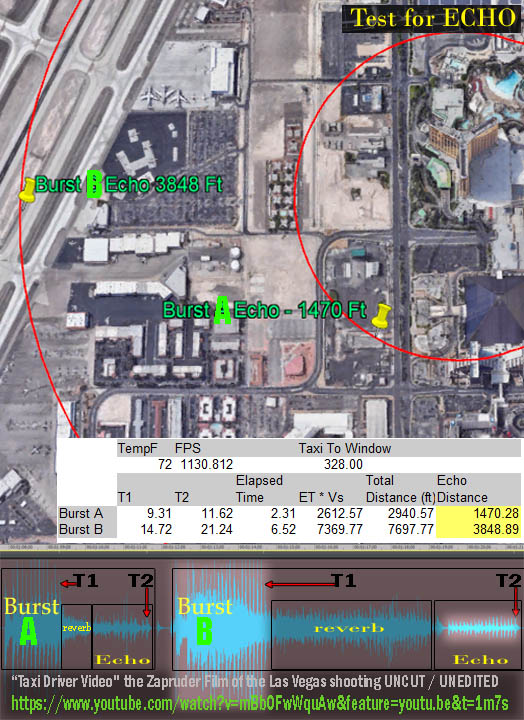
["Taxi Driver Video" the Zapruder Film of the Las Vegas shooting UNCUT / UNEDITED]
https://www.youtube.com/watch ?v=mBbOFwWquAw&feature=youtu.be&t=1m7s
and
https://www.youtube.com/watc h?v=mBbOFwWquAw&feature=youtu.be&t=1m24s
T1: Time from start of video (1minute N seconds) at the time of the last shot in the burst.
T2: Time from the start of the video (1minute N seconds) at the time of the echoed sound event corresponding to T1.
TempF: the air temperature (72 degrees F)
FPS: 1130 ft per second -- The speed of sound at 72 degrees F
Elapsed Time: T2 minus T1, the number of seconds between the last shot, and the echo of the last shot in each burst.
Total Distance: Elapsed Time * FPS = the total distance traveled between T1 and T2.
Echo Distance = The distance the echo traveled from the aiming point back to the point of origin.
===============
https://www.google.co m/search?biw=1544&bih=856&q=Forensic+Acoustics+gunfire
http://www.physic sclassroom.com/mmedia/waves/er.cfm
https://www.timeanddate.com/weather/usa/las- vegas/historic
http://www.csgnetwork.c om/soundspeedcalc.html
#81. To: VxH (#78)
All numbers he pulled out of his arse?
#82. To: nolu chan (#81)
(Edited)
The audio he used is presented.
#83. To: VxH (#82)
The amplitude graphs of the audio referenced on my meme can be reproduced by anyone with minimal tools. It's REPRODUCIBLE - that's what differentiates valid science from conspiratorial buffoonery.
#84. To: VxH, A K A Stone (#80)
My meme references, measures, and explains actual audio.
https://libertysflame.com/cgi-bin/readart.cgi?ArtNum=53025&Disp=42#C42
["Taxi Driver Video" the Zapruder Film of the Las Vegas shooting
UNCUT / UNEDITED]
https://www.youtube.com/watch ?v=mBbOFwWquAw&feature=youtu.be&t=1m7s
and
https://www.youtube.com/watc h?v=mBbOFwWquAw&feature=youtu.be&t=1m24s
===============
T1: Time from start of video (1minute N seconds) at the time of the last shot in the burst.
T2: Time from the start of the video (1minute N seconds) at the time of the echoed sound event corresponding to T1.
TempF: the air temperature (72 degrees F)
FPS: 1130 ft per second -- The speed of sound at 72 degrees F
Elapsed Time: T2 minus T1, the number of seconds between the last shot, and the echo of the last shot in each burst.
Total Distance: Elapsed Time * FPS = the total distance traveled between T1 and T2.
Echo Distance = The distance the echo traveled from the aiming point back to the point of origin. Las Vegas Shooting: Chaos at a Concert
and a Frantic Search at Mandalay Bay
UPDATED 10:30 PM ET, OCT. 2, 2017
#85. To: nolu chan (#84)
(Edited)
Your chartoon lists "Test for Echo" and gives links to the Taxi Driver video.
#86. To: nolu chan (#83)
That you reproduce meaningless bullshit is meaningful
#87. To: VxH (#85)
What part of TWO. SEPARATE. ANALYSIS. are you failing to comprehend?
#88. To: VxH (#86)
The amplitude graphs are reproducible...
#89. To: nolu chan (#88)
#90. To: VxH (#89)
Maybe you just don't have what it takes.
#91. To: nolu chan (#90)
(Edited)
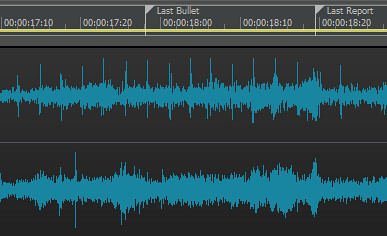
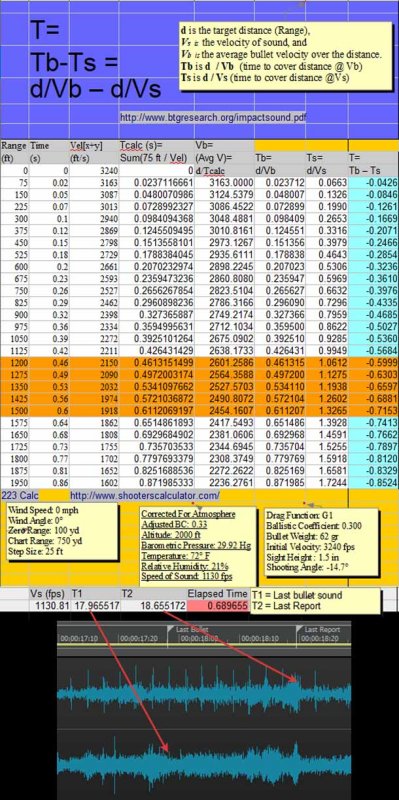
#92. To: VxH (#91)
Now, ask your donkey - what distance does that MEASURED absolute time difference correspond to on the chart?
Bullet Time, Velocity FPS, Tb–Ts
Tb = Time of bullet
Ts = Time of sound, 1.062 seconds @ 1,130 feet per second (FPS) (72ºF, 20% Humidity)
Ts – Tb = Time difference between Tb and Ts
Column 2 = Tb stepped in 100 FPS increments, beginning with Ts
Column 3 = Ts – Tb (time in seconds supersonic bullet arrives ahead of sound) Bullet time (s), Bullet average velocity (FPS), time difference to sound at 1,200 feet (s)
Bullet time (s) Bullet average vel FPS Time diff Ts-Tb 1.062 1130 0.000 0.976 1230 0.086 0.902 1330 0.160 0.839 1430 0.223 0.784 1530 0.278 0.736 1630 0.326 0.694 1730 0.368 0.656 1830 0.406 0.622 1930 0.440 0.591 2030 0.471 0.563 2130 0.499 0.538 2230 0.524 0.515 2330 0.547 0.494 2430 0.568 0.474 2530 0.588 0.456 2630 0.606 0.440 2730 0.622 0.424 2830 0.638 0.410 2930 0.652 0.396 3030 0.666 0.383 3130 0.679 0.372 3230 0.690 0.360 3330 0.702 0.350 3430 0.712 0.340 3530 0.722 0.331 3630 0.731 0.322 3730 0.740 0.313 3830 0.749 0.305 3930 0.757 0.298 4030 0.764
#93. To: nolu chan (#92)
(Edited)
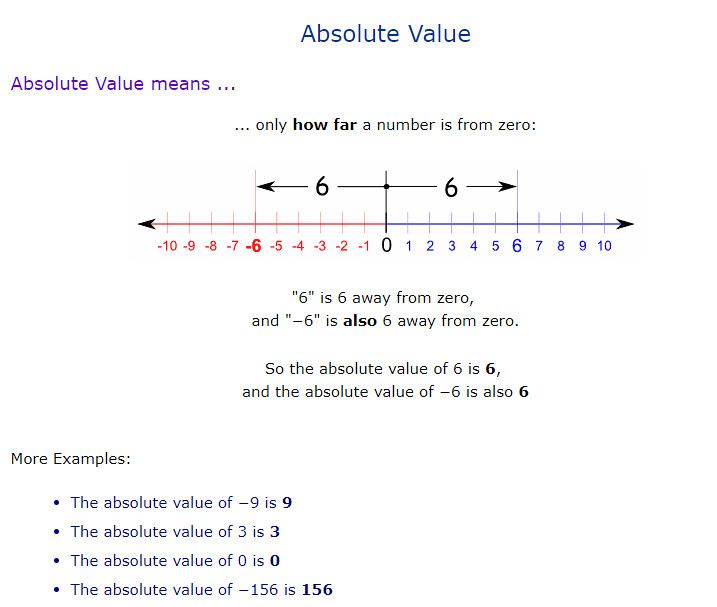
#94. To: nolu chan (#92)
(Edited)


#95. To: VxH (#93)
Since we KNOW from the observed audio Vb is supersonic, we can treat the difference between Tb and Ts as Absolute.
#96. To: nolu chan (#95)
(Edited)
They have a spreadsheet function for that.


#97. To: VxH (#96)

#98. To: nolu chan (#97)
(Edited)
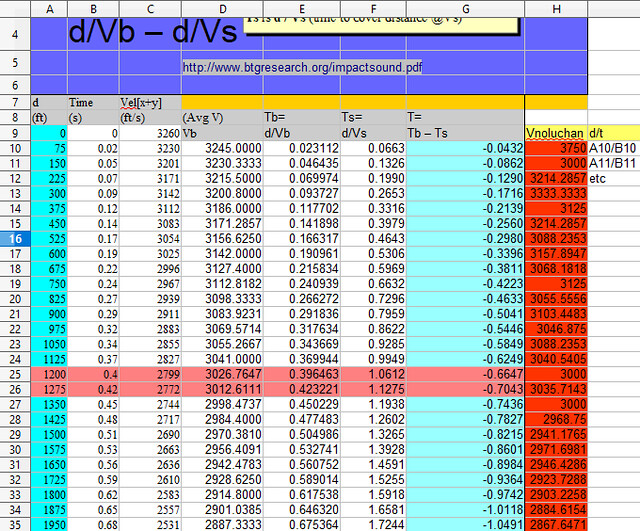
#99. To: nolu chan (#97)
(Edited)
Drag Function: G1
Ballistic Coefficient: 0.300
Bullet Weight: 62 gr
Initial Velocity: 3240 fps
Sight Height : 1.5 in
Shooting Angle: -33°Wind Speed: 0 mph
Wind Angle: 0°
Zero Range: 100 yd
Chart Range: 750 yd
Maximum Range: 50002 yd
Step Size: 25 ydCorrected For Atmosphere
Adjusted BC: 0.33
Altitude: 2000 ft
Barometric Pressure: 29.92 Hg
Temperature: 72° F
Relative Humidity: 21%
Speed of Sound: 1130 fpsRange Time Vel[x+y] (ft) (s) (ft/s) 0 0.00 3240 75 0.02 3163 150 0.05 3088 225 0.07 3014 300 0.10 2941 375 0.12 2870 450 0.15 2799 525 0.18 2730 600 0.20 2662 675 0.23 2595 750 0.26 2529 825 0.29 2465 900 0.32 2401 975 0.36 2337 1050 0.39 2275 1125 0.42 2214 1200 0.46 2154 1275 0.49 2095 1350 0.53 2036 1425 0.56 1979 1500 0.60 1923 1575 0.64 1867 1650 0.68 1813 1725 0.73 1760 1800 0.77 1708 1875 0.81 1658 1950 0.86 1609 2025 0.91 1561 2100 0.96 1515 2175 1.01 1470 2250 1.06 1426 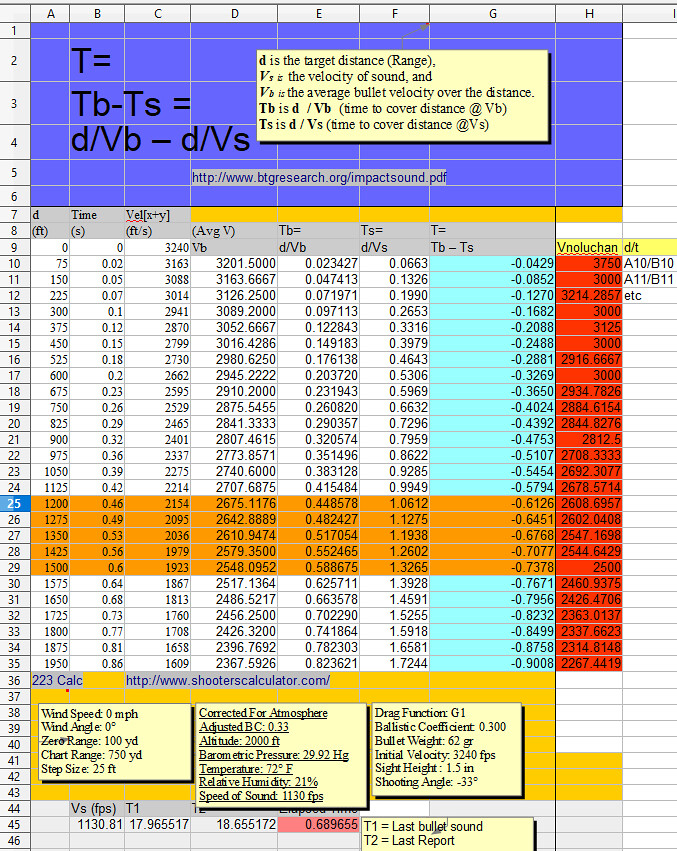

#100. To: VxH (#98)
Vs is the velocity of sound, and
Vb is the average bullet velocity over the distance
Tb is d / Vb (time to cover distance @ Vb)
Ts is d/Vs (time to cover distance @Vs) LOL please tell the class why the bullet accelerates / decelerates / accelerates repeatedly when your "analysis" is applied?
Keep in mind this is an approximation....
#101. To: VxH, A K A Stone (#99)
and the data was directly entered into the cells by hand.
I found/took their formula, built a spreadsheet, and plugged in 223 balistic data generated via shooterscalculator.com:
#102. To: nolu chan (#101)
(Edited)
=SUM(C$9:C11)/L10
=SUM(C$9:C12)/L11
etc.
Where column L contains 1 @ row 8 and =+L8+1, =+L9+1 etc for rows 9..34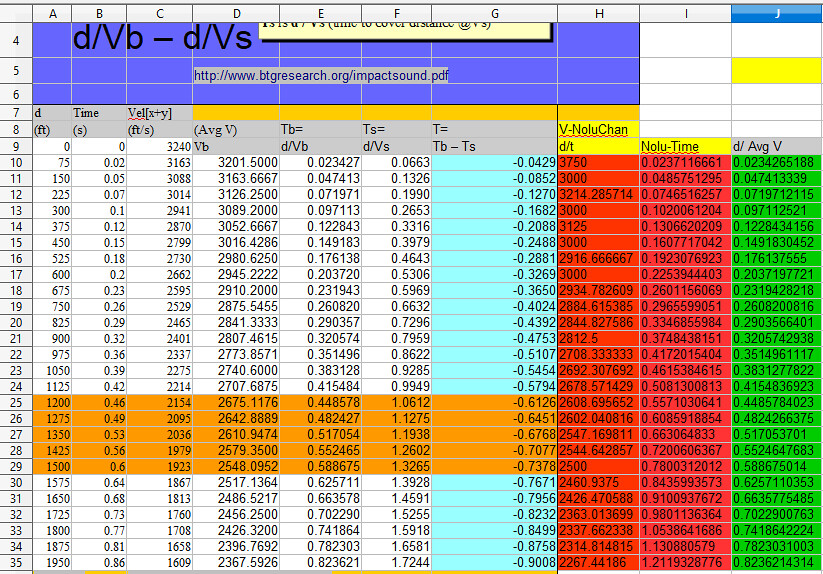
#103. To: VxH (#102)
.
.
.
[Home] [Headlines] [Latest Articles] [Latest Comments] [Post] [Mail] [Sign-in] [Setup] [Help] [Register]
